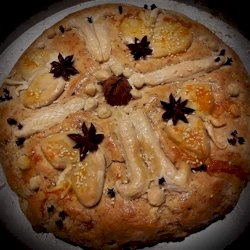Christopsomo - Christ's bread
CHRISTOPSOMO – CHRIST’S BREAD
It is a fact that in all Mediterranean peoples bread was strongly associated with special rituals related to the growth of the buried seed. A more than two thousand years old living tradition in which the preparation and baking of bread for holidays and other special occasions is used as a kind of offering to the "Divine" for health, fertility and life in general.
The first Christians used to exchange "σεμίδαλιν ψητήν" (baked finely sifted wheat flour) on the day after Christmas which was forbidden by the hierarchs "under penalty of excommunication" considering it as a remnant of an ancient ritual.
Christopsomo – Christ’s bread, used to be prepared the day before Christmas and we could say that it was a kind of bloodless sacrifice/offering. In other places, before they cut it, they incensed it. An olive branch was nailed to it, and figs, apples and oranges were placed on the branch. In Asia Minor they went around the table, raised it and said: "Christ is born, joy to the world, Keras tables, Panagia tables".
The landlord (as the pillar of the house) was the one who cut Christ’s bread (as well as the New Year's bread Vasilopita). First, he cut the piece of Christ and then the piece of the poor man. While they were cutting the Christmas bread, two pieces of wood placed crosswise were burning. All actions were symbolic with reference to family's unity, the importance of offering and flame.
Christopsomo is usually round serving as a circle, symbolic of eternity. The dough ornaments that decorated Christ’s bread were adapted according to the family occupations (lambs, sheep, donkeys, hen, shepherds etc.) or according to the social status of the family members (e.g. if there was an engaged daughter in the household, then the ornaments were related to marriage). Common features throughout Greece are grapes, vines, olive trees and daisies with their petals representing the number of family members. In the middle, the symbol of Cross always dominated, accompanied by many fruits (e.g. walnuts or even the Christmas tree known to all of us, which symbolizes the primitive tree-worshipping habits that were incorporated into Christian traditions).
In Tinos they formed a cross out of dough and put 5 walnuts in the middle and on the edges. Walnuts is considered a symbol of fertility or Virgin Mary virginity.
In Karpathos, Christ’s bread is called "gigla" and the brides prepared it for the mothers-in-law, while in Kasos and Kos the mothers-in-law offered the brides "harhaes".
In the region of Kastoria, villagers traditionally honoured their animals by making small individual Christopsomo biscuits representing each of their sheep, goats, donkeys, and horses.
In island, fishing or coastal communities, Christ’s bread can feature boats or fish.
Small breads in 8 shape representing an animal, a person or baby Jesus were given to children.
Slices of Christopsomo were offered to the first stranger or beggar who would come to the house.
Women used to go to the cemetery to pay their respects to their departed loved ones and distributed Christ’s breads to children and the poor.
The habits of preparing and cutting Christ’s bread vary throughout Greece, but the main characteristic in all regions is its sanctity. They did not throw away the crumbs, but burn them in the incense.
True works of art, all the festive goodies of old times were part of families' everyday life since they were not made just because "that's how it should be" but because they believed that if man creates then this creation will be returned to them in the form of a blessing.
Faith and respect for nature, which was once the exclusive provider of man's goods, made him love and make offerings to earth aiming at favourable treatment and reciprocation of fruits and health. People in old times considered themselves an integral part of nature and not its sovereign.....
So even if admittedly we would hardly compete with the art of decorating this special Christmas bread, we can still prepare it in a simple way in order to preserve our traditions and values.
Look for Christopsomo recipes in the traditional recipes
photo credits Vicky Petrovicki




